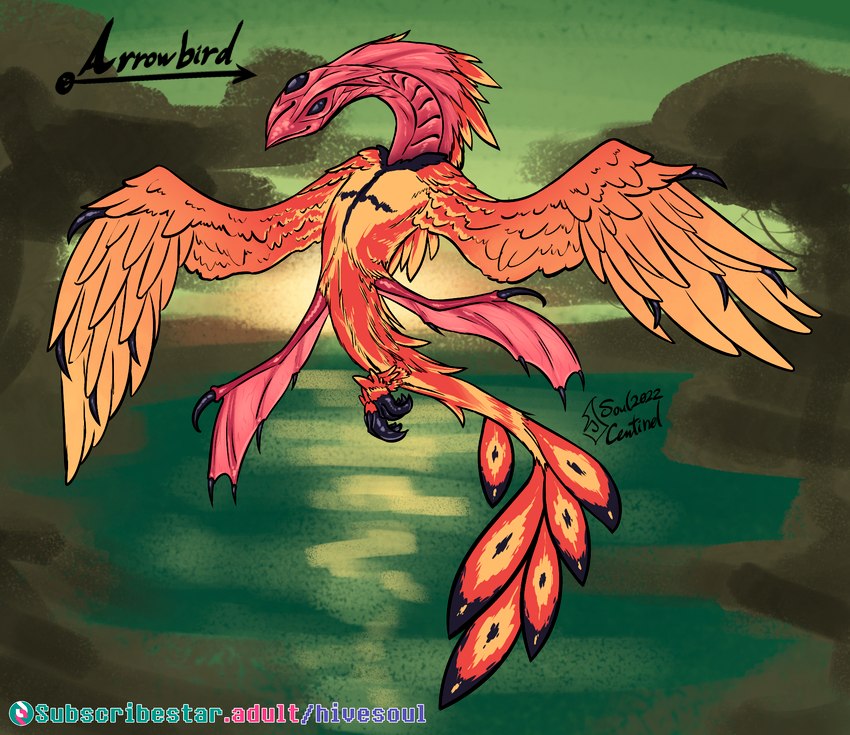Description
(Worldbuilding stuff is a bit out of order with this one, but H1's workflow is a bit longer than some of the other artists I commissioned for Parasite World pieces, so I'll just post more acorn bug stuff as it's finished, in-between other worldbuilding pieces.)
Arrowbirds
Extremely aggressive and territorial incubi. These (non-sapient) incubal feeders are found in multiple Layers of the Parasite World, but are most abundant in the topmost Layer of Nadayal. Though they appear superficially similar to birds, they are actually more akin to feathered reptiles.
As incubi, Arrowbirds feed exclusively on females of other species, specifically on vaginal secretions. To facilitate this, their mouths - which resemble beaks at a glance - are flexible and open to reveal multiple tentacle-like prehensile tongues. Their heads have radial symmetry, with multiple lips and eyes (specifically 4 eyes) arranged in a circular pattern. This eye pattern gives arrowbirds excellent vision in all directions, making it virtually impossible for prey, would-be predators, or rivals to escape their notice.
Arrowbirds are remarkably fast creatures, able to match the 320 km/h maximum diving speed of the Prime World Peregrine Falcon, and its maximum even flight speed of 130 km/h is even faster than the fastest known Prime bird, the Common Swift. It's speed goes beyond just flight, however. Arrowbird muscles are capable of incredible feats of acceleration, with some of the fastest reaction speeds in both the Prime and Parasite Worlds, comparable in swiftness to the flinching of single-celled organisms. This speed is in part allowed by the 'bird's incredible muscle strength. Though not particularly durable, Arrowbirds are remarkably strong; able to overpower an adult human for a short time with the right leverage. This combination of strength and speed makes them very difficult for prey or victims of territorial attacks to fend off the creatures. Any non-succubus or non-incubus that succeeds in attacking and killing one - difficult as that would be - will also find that arrowbirds aren't much use as a food source. Their meat contains immense amounts of capsaicin; the fuel their muscles use to enable the kinds of lightning quick flinching that arrowbirds are capable of. It's a tolerable amount for humans, but outright toxic to most denizens of the Parasite World.
Arrowbirds are considered pests in the Parasite World; their aggression is not always limited to potential competition. Their feeding is not inherently harmful aside from often leaving prey disoriented and a bit dehydrated, but arrowbirds can and will become violent if their prey fights back. They are even intelligent enough to feel defined frustration and spite, and are known to make their feeding especially uncomfortable or painful for prey that put up enough of a fight to anger them.
Arrowbirds males live solitary lives, while the more common females will often live in small groups of 2-4 individuals. When the two sexes meet, it is almost always for the purpose of (and shortly results in) mating, as the species is essentially in a permanent heat. This is likely in part why arrowbirds are so aggressive. The species is actually known to seek sexual gratification outside their own species if forced into an especially long "dry spell" without mates of the opposite sex. This on it's own is not especially bizarre in the Parasite World; animals in the Parasite World - including Prime animals who have lived there for enough generations - tend to have much higher sex drives than Prime natives and are less picky about sexual partners. Arrowbirds, though, go about this gratification with the aggressiveness they are known for in other walks of life. It isn't especially unusual for males to mate with females of other species that they subdue after feeding on them. Even males of other species aren't immune; though usually ignored by arrowbirds, males can and do find themselves accosted by sexually frustrated arrowbirds seeking to mate with them on occasion (usually with much angry clawing and screeching to be had in the process). Not always female ones either.
Note: this species' feeding habits will be shown in a separate pic

Squitoo
MemberNice stuff! It's genuinely interestingly reading about these species that you make; can't wait to see the sister pic and see how they feed.
Officer Hotpants
MemberRight? I get more into the descriptions than the pictures.
Login to respond »